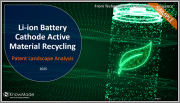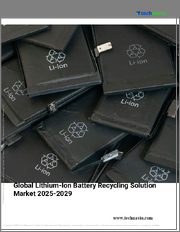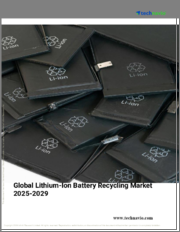
|
시장보고서
상품코드
1596915
리튬 이온 배터리 재활용 시장 규모, 점유율, 성장 분석 : 부문별 및 지역별 산업 예측(2024-2031년)Lithium-Ion Battery Recycling Market Size, Share, Growth Analysis, By Source (Automotive, Non-Automotive), By Battery Chemistry (LFP, NMC), By Battery Component, By Recycling Process, By Region - Industry Forecast 2024-2031 |
||||||
리튬 이온 배터리 재활용(Lithium-Ion Battery Recycling) 시장 규모는 2022년 32억 2,000만 달러로 평가되었고, 2023년 37억 9,000만 달러에서 2031년에는 149억 5,000만 달러로 성장해, 예측기간(2024-2031년)의 CAGR은 21.6%로 추이하며 성장할 전망입니다.
리튬 이온 배터리 재활용 시장은 우수한 전력 대 부하 비율로 선호되는 리튬 이온 배터리에 대한 수요 증가로 인해 예측 기간 후반기에 상당한 모멘텀을 얻을 것으로 예상됩니다. 가격 하락과 전기 자동차의 확산으로 인해 채택률이 급증함에 따라 배터리 폐기에 대한 우려와 점점 더 엄격해지는 정부 규제로 인해 재활용 이니셔티브에 대한 관심이 집중되고 있습니다. 그러나 재활용 부문의 성장은 재활용 공정과 관련된 높은 비용, 재활용 배터리에 대한 강력한 공급망 부족, 제한된 생산 능력 등의 문제에 직면해 있으며, 이는 예측 기간 동안 시장의 발전을 저해할 수 있습니다. 특히, 공공 및 민간 이해 관계자 모두 리튬 이온 배터리 재활용 환경을 강화하기 위해 광범위한 전략을 추진하고 있으며, 재사용 가능한 배터리의 판매를 크게 향상시킬 새로운 재활용 프로그램을 준비하고 있습니다. 이러한 이니셔티브는 향후 수십 년 동안 충전식 리튬 이온 배터리에 대한 증가하는 기술 수요를 충족하는 것을 목표로 합니다. 관련 사례로 2020년 12월 뉴욕주 로체스터에 최첨단 재활용 시설을 개장하여 약 95%의 놀라운 회수율을 달성한 캐나다 기업 Li Cycle을 들 수 있습니다. 이러한 개발은 재활용 요건을 충족하고 리튬 이온 배터리 생태계 내에서 지속 가능한 관행을 촉진하는 데 필수적인 요소입니다.
목차
소개
- 조사 목적
- 조사 범위
- 정의
조사 방법
- 정보 조달
- 2차 및 1차 데이터 방법
- 시장 규모 예측
- 시장 전제 조건 및 제한 사항
주요 요약
- 세계 시장 전망
- 공급 및 수요 동향 분석
- 부문별 기회 분석
시장 역학과 전망
- 시장 개요
- 시장 규모
- 시장 역학
- 성장 촉진요인 및 기회
- 억제요인 및 과제
- Porter's Five Forces 분석 및 영향
- 경쟁 기업간 경쟁 관계
- 대체품의 위협
- 구매자의 협상력
- 신규 진입업자의 위협
- 공급기업의 협상력
주요 시장 인사이트
- 중요 성공 요인
- 경쟁도
- 주요 투자 기회
- 시장 생태계
- 기술 진보
- 규제 상황
- 밸류체인 분석
- 사례 연구 분석
- PESTEL 분석
- 시장 매력 지수
- 공급망 분석
- 리튬 이온 배터리 재활용 애플리케이션에 대한 분석
리튬 이온 배터리 재활용 시장 규모 : 공급원별
- 시장 개요
- 자동차
- 자동차 이외
리튬 이온 배터리 재활용 시장 규모 : 배터리 화학별
- 시장 개요
- 리튬 니켈 망간 코발트(Li-NMC)
- 인산리튬 이온(LFP)
- 리튬망간산화물(LMO)
- 티탄산리튬 산화물(LTO)
- 리튬 니켈 코발트 알루미늄 산화물(NCA)
리튬 이온 배터리 재활용 시장 규모 : 배터리 구성 요소별
- 시장 개요
- 활물질
- 비활물질
리튬 이온 배터리 재활용 시장 규모 : 재활용 프로세스별
- 시장 개요
- 습식 야금 공정
- 고온 야금 공정
- 물리적/기계적 프로세스
리튬 이온 배터리 재활용 시장 규모 : 지역별
- 북미
- 미국
- 캐나다
- 유럽
- 영국
- 독일
- 스페인
- 프랑스
- 이탈리아
- 기타 유럽
- 아시아 태평양
- 중국
- 인도
- 일본
- 한국
- 기타 아시아 태평양
- 남미
- 브라질
- 기타 남미
- 중동 및 아프리카
- GCC 국가
- 남아프리카공화국
- 기타 중동 및 아프리카
경쟁 정보
- 상위 5개사 비교
- 주요 기업의 시장 포지셔닝(2023년)
- 주요 시장 기업이 채택한 전략
- 시장의 최근 동향
- 기업의 시장 점유율 분석(2023년)
- 주요 기업 프로파일
- 기업 개요
- 제품 포트폴리오 분석
- 부문별 점유율 분석
- 수익 전년대비 비교(2021-2023년)
주요 기업 프로파일
- Glencore(스위스)
- Umicore(벨기에)
- Cirba Solutions(미국)
- Contemporary Amperex Technology Co., Ltd.(중국)
- RecycLiCo Battery Materials Inc.(캐나다)
- Accurec Recycling GmbH(독일)
- American Battery Technology Company(미국)
- Ecobat(미국)
- Fortum(Finland)
- Gem Co., Ltd(중국)
- Aqua Metals, Inc.(미국)
- Li-Cycle Corp(캐나다)
- Neometals Ltd(호주)
- Redwood Materials Inc(미국)
- Stena Recycling(스웨덴)
- SK Tes(싱가폴)
- Velio(프랑스)
- ENVIROSTREAM AUSTRALIA PTY LTD.
- BATTERY RECYCLING MADE EASY
- DUESENFELD GMBH
결론 및 권장사항
LYJGlobal Lithium-Ion Battery Recycling Market size was valued at USD 3.22 billion in 2022 and is poised to grow from USD 3.79 billion in 2023 to USD 14.95 billion by 2031, growing at a CAGR of 21.6% in the forecast period (2024-2031).
The lithium-ion battery recycling market is poised to gain significant momentum in the latter half of the forecast period, driven by an escalating demand for lithium-ion batteries, which are favored for their superior power-to-load ratio. As adoption rates surge-largely spurred by declining prices and the proliferation of electric vehicles-concerns regarding battery disposal and increasingly stringent government regulations are intensifying the focus on recycling initiatives. However, the growth of the recycling sector faces challenges, including the high costs associated with recycling processes, a lack of robust supply chains for recycled batteries, and limited production capabilities, which could hinder advancements in the market during the forecast period. Notably, both public and private stakeholders are undertaking expansive strategies to bolster the lithium-ion battery recycling landscape, with new recycling programs set to enhance the sales of reusable batteries significantly. These initiatives aim to satisfy the rising technological demands for rechargeable lithium-ion batteries in the coming decades. A pertinent example is Canadian company Li Cycle, which, in December 2020, inaugurated a state-of-the-art recycling facility in Rochester, New York, achieving a remarkable recovery rate of approximately 95%. Such developments are integral to meeting the recycling requirements and facilitating sustainable practices within the lithium-ion battery ecosystem.
Top-down and bottom-up approaches were used to estimate and validate the size of the Global Lithium-Ion Battery Recycling market and to estimate the size of various other dependent submarkets. The research methodology used to estimate the market size includes the following details: The key players in the market were identified through secondary research, and their market shares in the respective regions were determined through primary and secondary research. This entire procedure includes the study of the annual and financial reports of the top market players and extensive interviews for key insights from industry leaders such as CEOs, VPs, directors, and marketing executives. All percentage shares split, and breakdowns were determined using secondary sources and verified through Primary sources. All possible parameters that affect the markets covered in this research study have been accounted for, viewed in extensive detail, verified through primary research, and analyzed to get the final quantitative and qualitative data.
Global Lithium-Ion Battery Recycling Market Segmental Analysis
Global Lithium-Ion Battery Recycling Market is segmented by Source, Battery Chemistry, Battery Component, Recycling Process and region. Based on Source, the market is segmented into Automotive, Non-Automotive. Based on Battery Chemistry, the market is segmented into Lithium-Nickel Manganese Cobalt (Li-NMC), Lithium-Ion Phosphate (LFP), Lithium-Manganese Oxide (LMO), Lithium-Titanate Oxide (LTO), Lithium-Nickel Cobalt Aluminum Oxide (NCA). Based on Battery Component, the market is segmented into Active Material, Non-Active Material. Based on Recycling Process, the market is segmented into Hydrometallurgical Process, Pyrometallurgy Process, Physical/ Mechanical Process. Based on region, the market is segmented into North America, Europe, Asia Pacific, Latin America and Middle East & and Africa.
Driver of the Global Lithium-Ion Battery Recycling Market
The surging demand for electric vehicles (EVs) significantly drives the global lithium-ion battery recycling market. As the production and sales of electric cars rise, the necessity for efficient end-of-life battery management becomes increasingly critical. Growing environmental concerns and the urgency to mitigate greenhouse gas emissions have intensified the global shift towards cleaner transportation solutions. Electric vehicles, recognized for their negligible exhaust emissions, are becoming preferred alternatives to traditional internal combustion engines. Furthermore, ongoing advancements in battery technology and EV design have resulted in improved driving ranges, faster charging capabilities, and enhanced overall efficiency, further fueling consumer interest and demand in this sector.
Restraints in the Global Lithium-Ion Battery Recycling Market
The growth of the Global Lithium-Ion Battery Recycling market may face challenges due to insufficient policies in several countries. The establishment of new recycling facilities demands substantial capital investment and a strong commitment to developing assembly and supply chains, which may not be readily available. Additionally, the absence of adequate regulations governing the disposal of battery products in numerous developing nations could further impede market expansion. As a result, the rising adoption of alternative battery types, such as lead batteries for recycling, may detract from the focus on lithium-ion battery recycling, thereby restraining overall market progress.
Market Trends of the Global Lithium-Ion Battery Recycling Market
The Global Lithium-Ion Battery Recycling market is experiencing robust growth, fueled by a surge in both public and private sector initiatives aimed at expanding recycling capacities. Key players are adopting strategic expansion efforts and launching innovative recycling programs, resulting in increased sales of reusable lithium-ion batteries. This transformative trend is not only enhancing sustainability efforts but is also driving significant demand for advanced technologies in rechargeable lithium-ion batteries. As environmental regulations tighten and electric vehicle adoption rises, the market is poised for accelerated growth, positioning lithium-ion battery recycling as a critical component of the circular economy in the years ahead.
Table of Contents
Introduction
- Objectives of the Study
- Scope of the Report
- Definitions
Research Methodology
- Information Procurement
- Secondary & Primary Data Methods
- Market Size Estimation
- Market Assumptions & Limitations
Executive Summary
- Global Market Outlook
- Supply & Demand Trend Analysis
- Segmental Opportunity Analysis
Market Dynamics & Outlook
- Market Overview
- Market Size
- Market Dynamics
- Driver & Opportunities
- Restraints & Challenges
- Porters Analysis & Impact
- Competitive rivalry
- Threat of substitute
- Bargaining power of buyers
- Threat of new entrants
- Bargaining power of suppliers
Key Market Insights
- Key Success Factors
- Degree of Competition
- Top Investment Pockets
- Market Ecosystem
- Technological Advancement
- Regulatory Landscape
- Value Chain Analysis
- Case Study Analysis
- PESTEL Analysis
- Market Attractiveness Index
- Supply Chain Analysis
- Analysis on Recycled Lithium-Ion Battery Applications
Global Lithium-Ion Battery Recycling Market Size by Source & CAGR (2024-2031)
- Market Overview
- Automotive
- Non-Automotive
Global Lithium-Ion Battery Recycling Market Size by Battery Chemistry & CAGR (2024-2031)
- Market Overview
- Lithium-Nickel Manganese Cobalt (Li-NMC)
- Lithium-Ion Phosphate (LFP)
- Lithium-Manganese Oxide (LMO)
- Lithium-Titanate Oxide (LTO)
- Lithium-Nickel Cobalt Aluminum Oxide (NCA)
Global Lithium-Ion Battery Recycling Market Size by Battery Component & CAGR (2024-2031)
- Market Overview
- Active Material
- Non-Active Material
Global Lithium-Ion Battery Recycling Market Size by Recycling Process & CAGR (2024-2031)
- Market Overview
- Hydrometallurgical Process
- Pyrometallurgy Process
- Physical/ Mechanical Process
Global Lithium-Ion Battery Recycling Market Size & CAGR (2024-2031)
- North America, (Source, Battery Chemistry, Battery Component, Recycling Process)
- US
- Canada
- Europe, (Source, Battery Chemistry, Battery Component, Recycling Process)
- UK
- Germany
- Spain
- France
- Italy
- Rest of Europe
- Asia-Pacific, (Source, Battery Chemistry, Battery Component, Recycling Process)
- China
- India
- Japan
- South Korea
- Rest of Asia Pacific
- Latin America, (Source, Battery Chemistry, Battery Component, Recycling Process)
- Brazil
- Rest of Latin America
- Middle East & Africa, (Source, Battery Chemistry, Battery Component, Recycling Process)
- GCC Countries
- South Africa
- Rest of Middle East & Africa
Competitive Intelligence
- Top 5 Player Comparison
- Market Positioning of Key Players, 2023
- Strategies Adopted by Key Market Players
- Recent Developments in the Market
- Company Market Share Analysis, 2023
- Company Profiles of All Key Players
- Company Details
- Product Portfolio Analysis
- Company's Segmental Share Analysis
- Revenue Y-O-Y Comparison (2021-2023)
Key Company Profiles
- Glencore (Switzerland)
- Company Overview
- Business Segment Overview
- Financial Updates
- Key Developments
- Umicore (Belgium)
- Company Overview
- Business Segment Overview
- Financial Updates
- Key Developments
- Cirba Solutions (US)
- Company Overview
- Business Segment Overview
- Financial Updates
- Key Developments
- Contemporary Amperex Technology Co., Ltd. (China)
- Company Overview
- Business Segment Overview
- Financial Updates
- Key Developments
- RecycLiCo Battery Materials Inc. (Canada)
- Company Overview
- Business Segment Overview
- Financial Updates
- Key Developments
- Accurec Recycling GmbH (Germany)
- Company Overview
- Business Segment Overview
- Financial Updates
- Key Developments
- American Battery Technology Company (US)
- Company Overview
- Business Segment Overview
- Financial Updates
- Key Developments
- Ecobat (US)
- Company Overview
- Business Segment Overview
- Financial Updates
- Key Developments
- Fortum (Finland)
- Company Overview
- Business Segment Overview
- Financial Updates
- Key Developments
- Gem Co., Ltd (China)
- Company Overview
- Business Segment Overview
- Financial Updates
- Key Developments
- Aqua Metals, Inc. (US)
- Company Overview
- Business Segment Overview
- Financial Updates
- Key Developments
- Li-Cycle Corp (Canada)
- Company Overview
- Business Segment Overview
- Financial Updates
- Key Developments
- Neometals Ltd (Australia)
- Company Overview
- Business Segment Overview
- Financial Updates
- Key Developments
- Redwood Materials Inc (US)
- Company Overview
- Business Segment Overview
- Financial Updates
- Key Developments
- Stena Recycling (Sweden)
- Company Overview
- Business Segment Overview
- Financial Updates
- Key Developments
- SK Tes (Singapore)
- Company Overview
- Business Segment Overview
- Financial Updates
- Key Developments
- Velio (France)
- Company Overview
- Business Segment Overview
- Financial Updates
- Key Developments
- ENVIROSTREAM AUSTRALIA PTY LTD.
- Company Overview
- Business Segment Overview
- Financial Updates
- Key Developments
- BATTERY RECYCLING MADE EASY
- Company Overview
- Business Segment Overview
- Financial Updates
- Key Developments
- DUESENFELD GMBH
- Company Overview
- Business Segment Overview
- Financial Updates
- Key Developments



















